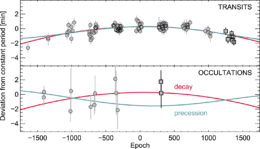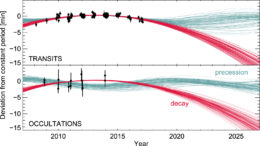Jupiter-like planets on orbits close to their hosts are predicted to spiral ever closer to their hosts until they meet their eventual demise — and yet we’ve never observed orbital decay. Could WASP-12b provide the first evidence?
Undetected Predictions
Since the discovery of the first hot Jupiter more than 20 years ago, we’ve studied a number of these peculiar exoplanets. Despite our many observations, two phenomena predicted of hot Jupiters have not yet been detected, due to the long timescales needed to identify them:
- Tidal orbital decay
Tidal forces should cause a hot Jupiter’s orbit to shrink over time, causing the planet to eventually spiral into its host star. This phenomenon would explain a number of statistical properties of observed star-planet systems (for instance, the scarcity of gas giants with periods less than a day). - Apsidal precession

An illustration of apsidal precession. [Mpfiz]
The orbits of hot Jupiters should be apsidally precessing on timescales of decades, as long as they are at least slightly eccentric. Since the precession rate depends on the planet’s tidally deformed mass distribution, measuring this would allow us to probe the interior of the planet.
A team of scientists led by Kishore Patra (Massachusetts Institute of Technology) think that the hot Jupiter WASP-12b may be our first chance to study one of these two phenomena. The question is, which one?
WASP-12b
WASP-12b has orbital period of 1.09 days — one of the shortest periods observed for a giant planet — and we’ve monitored it for a decade, making it a great target to test for both of these long-term effects.

Timing residuals for WASP-12b. Squares show the new data points, circles show previous data from the past decade. The data are better fit by the decay model than the precession model, but both are still consistent. [Patra et al. 2017]
The results show that a constant period for WASP-12b is firmly ruled out — this planet’s orbit is definitely changing over time. The observations are best fit by a model in which the planet’s orbit is tidally decaying, but a 14-year apsidal precession cycle can’t be definitively ruled out.
Future Prospects

Possible futures for WASP-12b’s orbit, based on the decay model (red) and the precession model (blue). We should be able to differentiate between these models with a few more years of observations. [Patra et al. 2017]
While we can’t yet state for certain that WASP-12b’s orbit is decaying, the authors argue that we should be able to tell conclusively with a few more years of observations. Either of the two outcomes above — orbital decay or apsidal precession — would have exciting scientific implications, however: if WASP-12b’s orbit is decaying, we can measure the tidal dissipation rate of the star. If its orbit is apsidally precessing, we may be able to measure the tidal deformability of an exoplanet. Future observations of this hot Jupiter should prove interesting!
Citation
Kishore C. Patra et al 2017 AJ 154 4. doi:10.3847/1538-3881/aa6d75


4 Comments
Pingback: exterminating WASP-12b?
Pingback: WASP-12b y su posible final ardiente – Observatori Astronòmic
Pingback: Posible final ardiente « SEDA / LIADA - RedLIADA - Cursos LIADA - Cielo del Mes - Fenómenos Astronómicos - RELEA
Pingback: WASP-12b y su posible final ardiente | Sección de Exoplanetas - Planetas extrasolares / LIADA Liga Iberoamericana de Astronomía